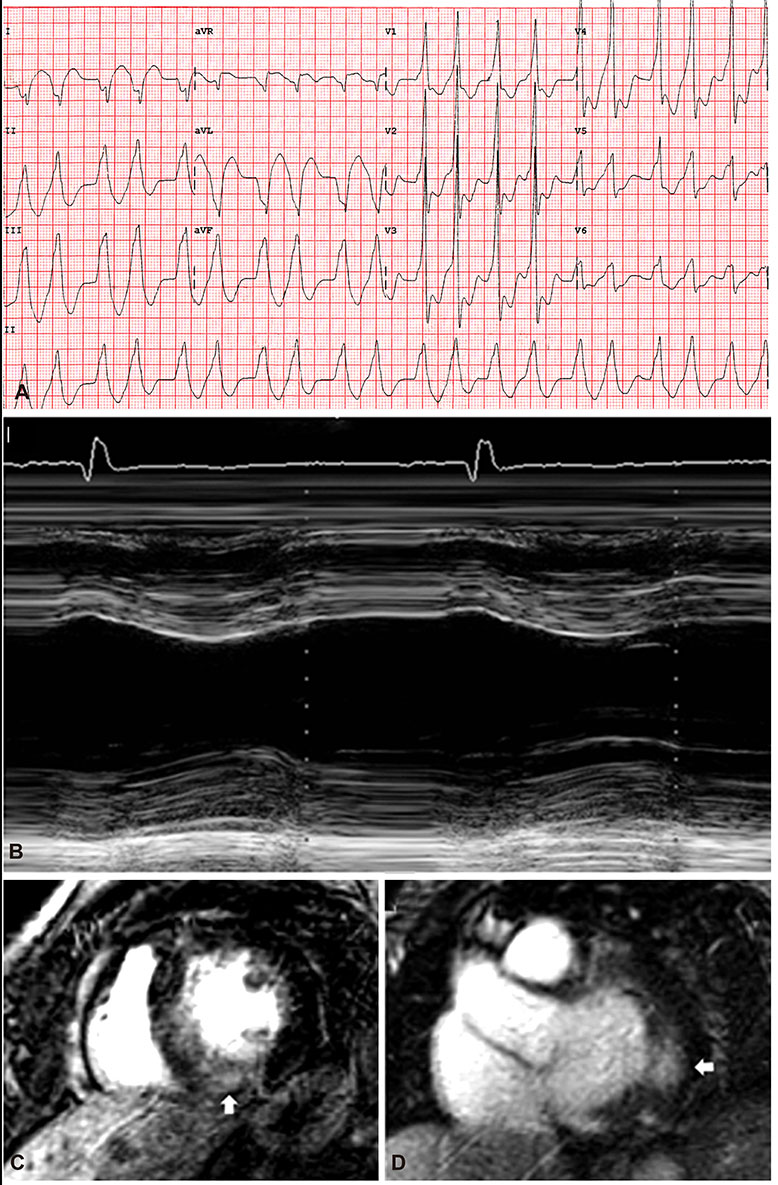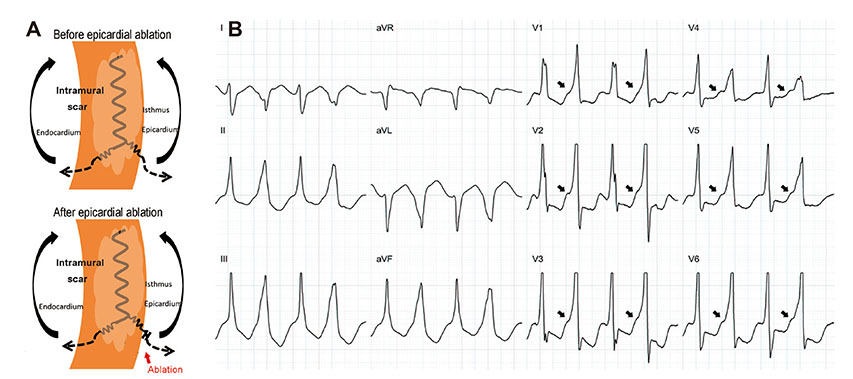Korean Circ J.
2015 Nov;45(6):526-530. 10.4070/kcj.2015.45.6.526.
Intramural Reentrant Ventricular Tachycardia in a Patient with Severe Hypertensive Left Ventricular Hypertrophy
- Affiliations
-
- 1Division of Cardiology, Department of Medicine, Taipei Veterans General Hospital, Taipei, Taiwan. epsachen@ms41.hinet.net
- 2Institute of Clinical Medicine, and Cardiovascular Research Center, National Yang-Ming University, Taipei, Taiwan.
- KMID: 2223793
- DOI: http://doi.org/10.4070/kcj.2015.45.6.526
Abstract
- We describe the case of a patient with severe hypertensive left ventricular hypertrophy and sustained hemodynamically unstable ventricular tachycardia (VT). Entrainment was demonstrated in the electrophysiological study. Activation mapping and pacemapping identified the location of the intramural reentrant VT with the exit site close to the epicardium. However, VT persisted after ablation at the epicardial exit site. Successful ablation was performed endocardially at the corresponding position.
MeSH Terms
Figure
Reference
-
1. Frohlich ED, Apstein C, Chobanian AV, et al. The heart in hypertension. N Engl J Med. 1992; 327:998–1008.2. Kannel WB, Doyle JT, McNamara PM, Quickenton P, Gordon T. Precursors of sudden coronary death. Factors related to the incidence of sudden death. Circulation. 1975; 51:606–613.3. McLenachan JM, Henderson E, Morris KI, Dargie HJ. Ventricular arrhythmias in patients with hypertensive left ventricular hypertrophy. N Engl J Med. 1987; 317:787–792.4. Dunn FG, Pringle SD. Left ventricular hypertrophy and myocardial ischemia in systemic hypertension. Am J Cardiol. 1987; 60:19I–22I.5. Levy D, Garrison RJ, Savage DD, Kannel WB, Castelli WP. Prognostic implications of echocardiographically determined left ventricular mass in the Framingham Heart Study. N Engl J Med. 1990; 322:1561–1566.6. Kannel WB, Castelli WP, McNamara PM, McKee PA, Feinleib M. Role of blood pressure in the development of congestive heart failure. The Framingham study. N Engl J Med. 1972; 287:781–787.7. Galinier M, Balanescu S, Fourcade J, et al. Prognostic value of ventricular arrhythmias in systemic hypertension. J Hypertens. 1997; 15(12 Pt 2):1779–1783.8. Vallès E, Bazan V, Marchlinski FE. ECG criteria to identify epicardial ventricular tachycardia in nonischemic cardiomyopathy. Circ Arrhythm Electrophysiol. 2010; 3:63–71.9. Hutchinson MD, Gerstenfeld EP, Desjardins B, et al. Endocardial unipolar voltage mapping to detect epicardial ventricular tachycardia substrate in patients with nonischemic left ventricular cardiomyopathy. Circ Arrhythm Electrophysiol. 2011; 4:49–55.10. Lorell BH, Carabello BA. Left ventricular hypertrophy: pathogenesis, detection, and prognosis. Circulation. 2000; 102:470–479.11. Messerli FH, Ventura HO, Elizardi DJ, Dunn FG, Frohlich ED. Hypertension and sudden death. Increased ventricular ectopic activity in left ventricular hypertrophy. Am J Med. 1984; 77:18–22.12. Pringle SD, Dunn FG, Macfarlane PW, McKillop JH, Lorimer AR, Cobbe SM. Significance of ventricular arrhythmias in systemic hypertension with left ventricular hypertrophy. Am J Cardiol. 1992; 69:913–917.13. Ghali JK, Kadakia S, Cooper RS, Liao YL. Impact of left ventricular hypertrophy on ventricular arrhythmias in the absence of coronary artery disease. J Am Coll Cardiol. 1991; 17:1277–1282.14. Dukkipati SR, d'Avila A, Soejima K, et al. Long-term outcomes of combined epicardial and endocardial ablation of monomorphic ventricular tachycardia related to hypertrophic cardiomyopathy. Circ Arrhythm Electrophysiol. 2011; 4:185–194.
- Full Text Links
- Actions
-
Cited
- CITED
-
- Close
- Share
- Similar articles
-
- Influence of left ventricular hypertrophy on ventricular arrhythmias in hypertensive patients
- Interrelated Atrioventricular Reentrant Tachycardia and Idiopathic Left Ventricular Tachycardia in a Patient with Manifested Bystander Accessory Pathway
- A Comparative Study of Left Ventricular Diastolic Function between Hypertrophic Cardiomyopathy and Hypertensive Patients with Left Ventricular Hypertrophy
- Effect of Left Ventricular Hypertrophy on Ventricular Performance in Essential Hypertension
- Left Ventricular Diastolic Functions by M-Mode Echocardiogram in Essential Hypertensive Patients




